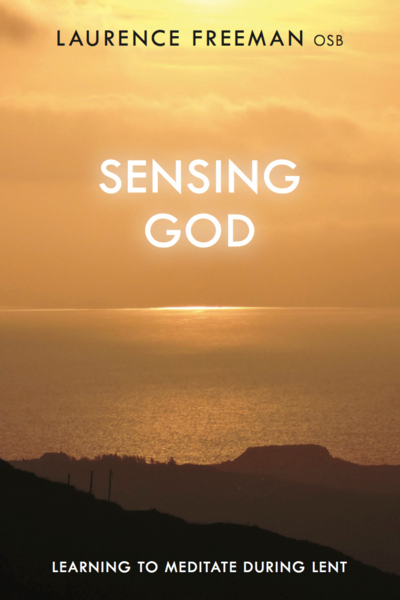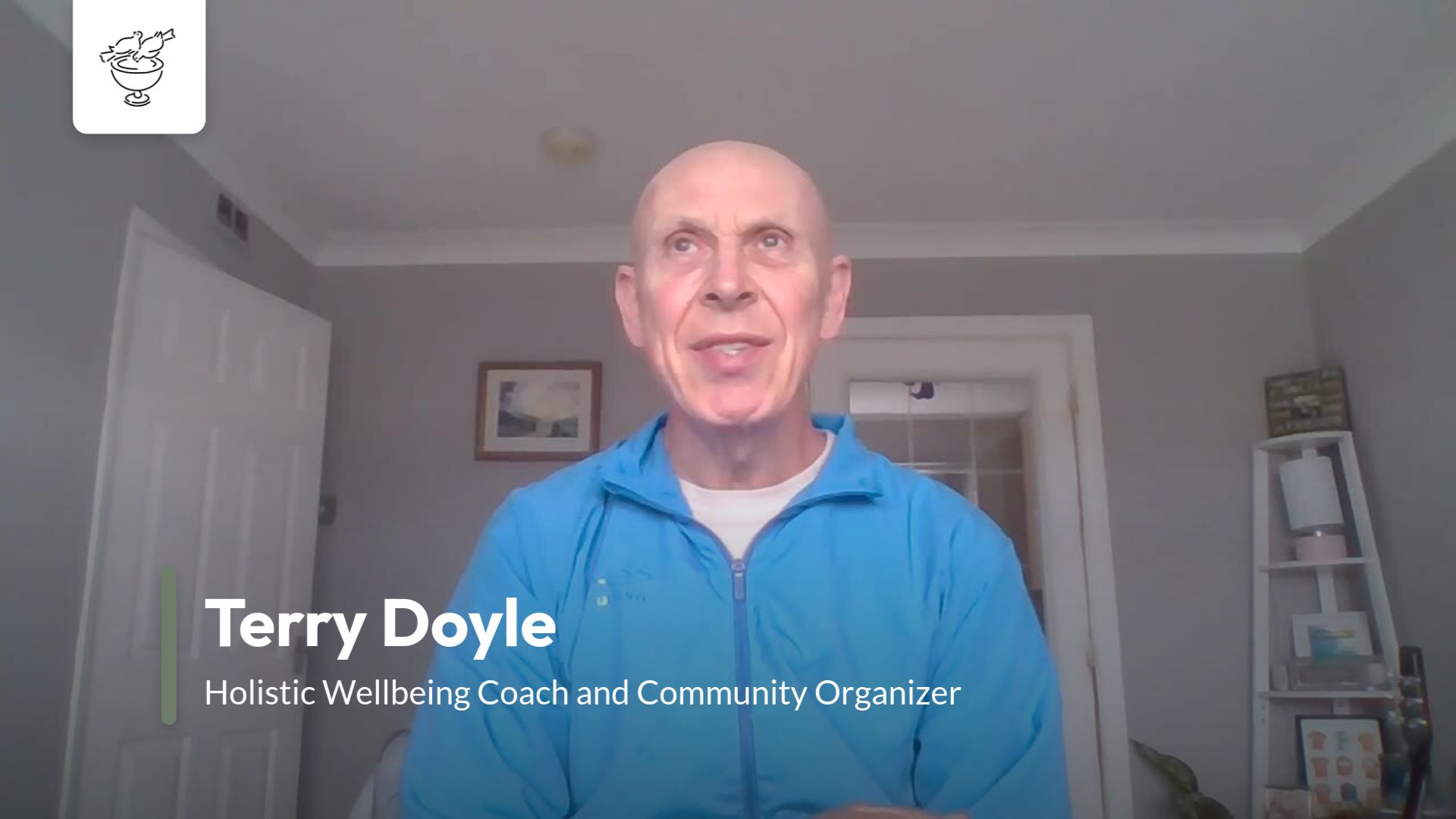We often associate Lent with “giving something up”, but it is also a good time to begin or to deepen the practice of meditation. ‘Sensing God’ is a practical introduction and guide to meditation in the Christian tradition and illuminated by scripture. The book shows how to meditate and offers personal support in the 46 inspiring daily reflections on the Gospels.
“This book is a guide and, I hope, a friendly companion to an interior journey of forty days that you can make through the Christian period of Lent. It can also be a way of beginning to make the practice of meditation a part of your daily life.”
Listen here to Laurence Freeman’s reading out the introduction to his book or, if you prefer, you can read his full introduction below.
Sensing God
by Laurence Freeman OSB
“Forty is one of those numbers that seem to turn up everywhere. It has many symbolic meanings but in biblical terms, as well as in the Asian traditions, it points to the idea of process, a time of trial or preparation during which people are got ready for the next stage in their development. The Hebrews spent forty years in the wilderness before entering their promised land; Jesus spent forty days fasting in the desert before beginning to teach publicly; Mohammed spent forty days fasting in a cave and the Buddha sat for the same length of time meditating under the bodhi tree. According to kabala it takes forty years to complete a cycle of transformation from intention to integration.
This book is a guide and, I hope, a friendly companion to an interior journey of forty days that you can make through the Christian period of Lent. It can also be a way of beginning to make the practice of meditation a part of your daily life.
Like the number forty, meditation is found in all the major religious traditions. Not, however, as a symbolic idea but as a practice. What is meditation? Firstly, it is truly simple and that is why it is universal. The truly universal is always simple. But that does not mean it is also easy. Young children find meditation entirely natural and they certainly enjoy it. Perhaps they don’t find it ‘easy’ but, because they approach it more as play (re-creation) than as a solemn struggle or obligation, they can meditate and choose to meditate. This means they experience the benefits and fruits of the practice very directly.
By ‘benefits’ I mean things you can measure, like blood-pressure, stress-levels, sleep patterns and so on, all of which seem to be beneficially influenced by meditation. By ‘fruits’ I mean things that you can’t measure but you certainly are aware of. These are even more important to the human and humane quality of life – things like love, joy, peace, patience, gentleness, kindness and self-control.
In recent years mindfulness-training – a form of Buddhist practice adapted to the modern secular and scientific culture – has attracted much attention for the benefits it is claimed to bestow. Some skepticism is often raised by the scientific quality of these claims but clearly people practice it because it makes them feel better.
Meditation is another step, however, even more simple and yet in a way more challenging because of this more radical simplicity. In mindfulness techniques the attention remains on yourself (thoughts, feelings, sensations, body scan). In meditation the work is to take the attention off yourself. This is the simplest and hardest thing in the world to do and yet also the most transformative and liberating.
Meditation is a discipline and you will appreciate this for yourself as soon as you try it. The word ‘discipline’ comes from the Latin ‘discere’, meaning to learn. We need discipline of course in learning a language, a musical instrument, to drive a car or to love and stay in a relationship. Discipline is not helpful if it is imposed by an external force against our will (except perhaps when we are two years old). If it is to work discipline needs to be freely accepted and followed. This is especially true of a spiritual discipline. And yet without discipline we remain locked under the control of our ego and its repertoire of fears, anxieties, fantasies and desires. We are free only when we can choose to say ‘yes’ or ‘no’ from a place of enlightened self-knowledge.
Meditation is a learning process. As with any discipline it is natural and useful to join up with others who are learning the same thing. Learning together makes the acquisition of new knowledge easier and quicker. In meditation the new knowledge is actually more of a new way of knowing rather than additional information. A very new meditator told me that he knew the daily practice was working because his wife told him that he was easier to live with and that he was paying her more attention and also because, on his walk to work every morning, he discovered that he was noticing the world around him rather than, as before, being compulsively trapped in his own stressful plans and anxieties. Like many people learning to meditate he found it very helpful to meditate with others on a regular basis, in person or even online.
Meditation is solitary – I cant meditate for you and you cant meditate for me. We have to take personal responsibility for learning it. But at the same time meditation is communal – it gives us a real and stronger sense of relationship and interdependence. In fact it is not exaggeration to say that meditation will make you a more loving person. However you perceive or describe it, the practice of meditation that this book can help you start will lead to a change in you. So, don’t meditate if you don’t want to change.
The forty days and nights of Lent are about simplification, purification, getting priorities re-established and remembering that God, not my ego, is the centre of reality. Whatever discipline you take up for Lent (giving up sweets or alcohol, doing spiritual reading, spending more time with your loved ones, helping someone in need) it is about this – simplification and purification.

“Meditation is solitary – I can’t meditate for you and you cant meditate for me. We have to take personal responsibility for learning it. But at the same time meditation is communal – it gives us a real and stronger sense of relationship and interdependence. “
The ancient word for this discipline was ‘ascesis’ and it was used as a metaphor from the training exercises of athletes. Lent is a time for spiritual ascesis or exercise, shedding some unnecessary mental fat, toning the muscles of attention and patience. This book can also help you use the forty days to learn to meditate. If you do this you might find that what you learn will not end on Easter Sunday but will stay with you and enrich your daily life for the rest of your life’s journey.
I have spoken above about meditation but haven’t said yet how to do it. The way of meditation I would recommend is in many ways universal but also an integral part of the Christian tradition of prayer. In this tradition it is called the ‘prayer of the heart’. This distinguishes it from either mental prayer or the external forms of worship with which many Christians have come to identify prayer.
Prayer is like a wheel with many spokes. The different spokes represent different forms of prayer – these can be explicitly religious such as those we practice in church – or less obviously so – like walking, exercise, making music or art. Whatever concentrates our attention in a selfless way can be said to be a form of prayer. The fruit of all prayer is a calmer mind and a more open and compassionate heart.
In this way of meditation – praying in the heart, or what Jesus calls the ‘inner room’ – we are not speaking to God or thinking about God or asking God for things. Meditation is not what you think. We are being with God.
The early Christian monks, the desert fathers and mothers, said that meditation is the ‘laying aside of thoughts’. This means good and bad thoughts, silly as well as wise ones. In meditation we are not trying to have good or better thoughts. If you get an inspired solution to a problem you are troubled by, let it go and it should be there when you finish your meditation (although it may not feel so inspired then!).
Sit down with your back straight. You can use a straight-backed chair or a cushion or meditation bench. Sit alert and comfortably so that you can sit still throughout the meditation. Close your eyes lightly. Begin to repeat a single word or ‘mantra’ and try to repeat it continuously, faithfully throughout the period of the meditation. When thoughts, problems, plans, memories, fantasies, anxieties, whatever, rise in the mind let them go and return your attention to the mantra. I recommend the word ‘maranatha’. This is an ancient Christian prayer-word but also one that can also be used by all, young and old, those with faith and those without. It means ‘Come Lord’ but we are not consciously thinking of its meaning while we repeat it. If you choose this word say it as four syllables: ma ra na tha. Articulate it clearly in the mind and listen to it as you repeat it.

“In this way of meditation – praying in the heart, or what Jesus calls the ‘inner room’ – we are not speaking to God or thinking about God or asking God for things. Meditation is not what you think. We are being with God“
The simplicity and stillness of the mantra will lead you into the silence that is pure prayer. There is nothing so much like God as silence, according to Meister Eckhart. The simple discipline is to say the mantra from the beginning to end of the meditation – as best you can. Don’t evaluate yourself. The thought of failure is just another thought to lay aside.
Saying the mantra is the interior form of the discipline of meditation. Actually sitting down to it every day is the outer form. Early morning and early evening are the ideal times but we have to adapt to circumstances. In the morning try to meditate before you check your emails or listen to the news. You can read the Lenten reading for the day from this book after the meditation. In the evening, try not to leave the second meditation too late as you may find that the spirit is willing but the flesh is weak. You can re-read the daily reading from the morning. In this way it will help you to find a balance and stability in your daily life, whatever kind of day it has been.
A lot can happen in forty days and forty nights. More useful things will happen if we enter into this period of sweet discipline with open hearts and minds, with conscious attention. It’s not about succeeding, however, but it’s about simply being faithful. That’s when the most interesting, enlivening things happen. It is then that our sense of God is opened, transforming everything.”

” Laurence Freeman has the ability to say profound and revelatory things in simple
sentences and convincing voice that could only come from a very clear place within.
This is a rich feast that will not just feed but might just transform the reader. It will
lead you through a new kind of Lent.”
Fr. Richard Rohr, O.F.M. Center for Action and Contemplation, Albuquerque, New
Mexico
You can order your copy of Sensing God from the WCCM Media page here.



